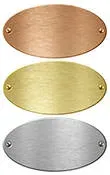 Central America is full of natural resources. All manner of metals - gold, silver, bronze and copper, are found here, as well as many manners of decorative stones. The people who have lived in Central America have always made use of these available materials to stunning effect.
Central America is full of natural resources. All manner of metals - gold, silver, bronze and copper, are found here, as well as many manners of decorative stones. The people who have lived in Central America have always made use of these available materials to stunning effect.
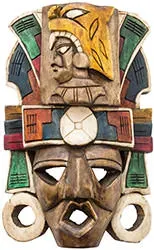 The Maya people lived in the Yucatan Peninsula in the area now known as Belize and Guatemala since 1800 BC. Always a sedentary people, the height of Mayan urban development was reached during the first millennium AD. During this time, their architecture, language and all manner of cultural production grew to awe-inspiring heights and they began to participate in trade with many other group in their region. Through trade, then, their influence extended into what is now central Mexico.
The Maya people lived in the Yucatan Peninsula in the area now known as Belize and Guatemala since 1800 BC. Always a sedentary people, the height of Mayan urban development was reached during the first millennium AD. During this time, their architecture, language and all manner of cultural production grew to awe-inspiring heights and they began to participate in trade with many other group in their region. Through trade, then, their influence extended into what is now central Mexico.
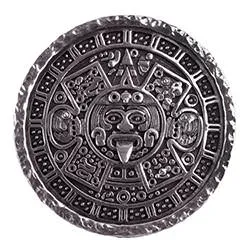 Mayan women pierced the cartilage that separated their nostrils, inserting ivory through the hole. Women and men wore the same sorts of earrings, which were made of
Mayan women pierced the cartilage that separated their nostrils, inserting ivory through the hole. Women and men wore the same sorts of earrings, which were made of ![]() jade, gold, silver, bronze or copper. Those Mayan women living in communities closer to Mexico preferred to wear earplugs, pendants and bracelets of jade. Noted for their wonderfully advanced carving and shallow relief in art and architecture, the Mayan people also boasted intricately carved jewelry and complex tattooed patterns on their skin. Many of the motifs in ancient Mayan designs were derived from nature and featured the forms of animals. Jewelry was used in sacrificing to the gods and it was also a signifier of social status. In the excavation of Mayan King Jasaw Chan K'awill, it was found that he was laid out on jaguar skin in all of his fine jade jewelry and accompanied like an Egyptian Pharaoh with many of his valuable pieces.
jade, gold, silver, bronze or copper. Those Mayan women living in communities closer to Mexico preferred to wear earplugs, pendants and bracelets of jade. Noted for their wonderfully advanced carving and shallow relief in art and architecture, the Mayan people also boasted intricately carved jewelry and complex tattooed patterns on their skin. Many of the motifs in ancient Mayan designs were derived from nature and featured the forms of animals. Jewelry was used in sacrificing to the gods and it was also a signifier of social status. In the excavation of Mayan King Jasaw Chan K'awill, it was found that he was laid out on jaguar skin in all of his fine jade jewelry and accompanied like an Egyptian Pharaoh with many of his valuable pieces.
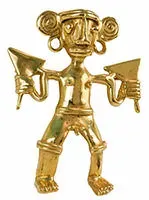 The Aztecs occupied what is now Mexico. Ancient Mexican gold objects are sometimes attributed to the Mixtec people, who were contemporaries of the Aztecs in the south of Mexico. The Aztec elite sought out jewelry from these artisans, but Aztecs clearly had their own craftsmen as well, and it is sometimes impossible to tell the difference at this point between the jewelry of the two cultures, since very few pieces survived colonization for contemporary study and comparison.
The Aztecs occupied what is now Mexico. Ancient Mexican gold objects are sometimes attributed to the Mixtec people, who were contemporaries of the Aztecs in the south of Mexico. The Aztec elite sought out jewelry from these artisans, but Aztecs clearly had their own craftsmen as well, and it is sometimes impossible to tell the difference at this point between the jewelry of the two cultures, since very few pieces survived colonization for contemporary study and comparison.
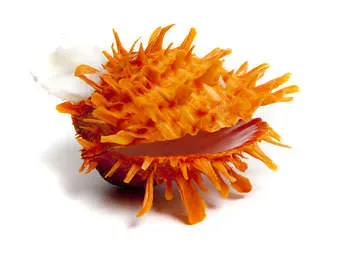 Only nobility wore gold jewelry, which showed their power, rank, and wealth. They decorated their bodies with bird feathers and wore necklaces of numerous small beads shaped like animals. Animals that were especially popular were associated with water and rain and therefore sustenance. Each of these ornaments were cast individually by the lost-wax process. Each piece was slightly different in detail, as the mold was broken after each casting so that the gold piece could be extracted. Other jewelry was made from Spondylus ï¾– the red-orange shell of a thorny oyster. It was carved and rendered into pendants and has been found repeatedly in the tombs of important individuals. Turquoise and clay were also carved into figures and worn as pendants. Breast ornamentation of hammered and cast gold were soldered together and decorated with cast thread.
Only nobility wore gold jewelry, which showed their power, rank, and wealth. They decorated their bodies with bird feathers and wore necklaces of numerous small beads shaped like animals. Animals that were especially popular were associated with water and rain and therefore sustenance. Each of these ornaments were cast individually by the lost-wax process. Each piece was slightly different in detail, as the mold was broken after each casting so that the gold piece could be extracted. Other jewelry was made from Spondylus ï¾– the red-orange shell of a thorny oyster. It was carved and rendered into pendants and has been found repeatedly in the tombs of important individuals. Turquoise and clay were also carved into figures and worn as pendants. Breast ornamentation of hammered and cast gold were soldered together and decorated with cast thread.
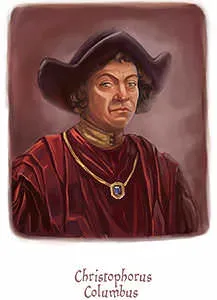 Gold was one of the driving factors in the exploration of lands outside of Europe. Christopher Columbus was looking for Japan because it was described by Marco Polo as an island of endless gold, but instead of course, Columbus found (and claimed for King Ferdinand and Queen Isabella of Spain) an island in the Caribbean: he said that the people he encountered wore little pieces of gold suspended from holes in their noses. He wanted to find out where they got the gold and how much was available. As he sailed among these islands, he asked often about gold. Locals brought gold pieces to the ship ï¾– some for trade and some as gifts ï¾– and Columbus thought that indeed he had found what he was looking for. He later learned that there was no mine for gold where he had arrived, but he had already convinced Europeans that this was a land of golden opportunity.
Gold was one of the driving factors in the exploration of lands outside of Europe. Christopher Columbus was looking for Japan because it was described by Marco Polo as an island of endless gold, but instead of course, Columbus found (and claimed for King Ferdinand and Queen Isabella of Spain) an island in the Caribbean: he said that the people he encountered wore little pieces of gold suspended from holes in their noses. He wanted to find out where they got the gold and how much was available. As he sailed among these islands, he asked often about gold. Locals brought gold pieces to the ship ï¾– some for trade and some as gifts ï¾– and Columbus thought that indeed he had found what he was looking for. He later learned that there was no mine for gold where he had arrived, but he had already convinced Europeans that this was a land of golden opportunity.
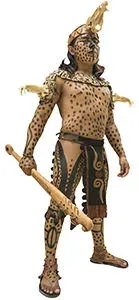 The Spanish arrived in Guatemala in 1523. The invaders defeated the Mayan forces, took over the positions of the elite and consolidated the lower rungs of the social strata into easily controllable villages. This way, they could have an easy pick for labor for their haciendas as well as parishioners for their church. They could also control the small, concentrated groups of people more effectively than before. A side effect of this practice is that some of the traditional customs of this group were preserved, if not any of the finery that would have been passed on with the elite.
The Spanish arrived in Guatemala in 1523. The invaders defeated the Mayan forces, took over the positions of the elite and consolidated the lower rungs of the social strata into easily controllable villages. This way, they could have an easy pick for labor for their haciendas as well as parishioners for their church. They could also control the small, concentrated groups of people more effectively than before. A side effect of this practice is that some of the traditional customs of this group were preserved, if not any of the finery that would have been passed on with the elite.
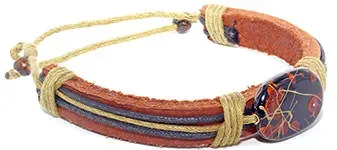 Mayan society had begun to decline across the Yucatan in the 10th century, and after colonization, of course, that descent was swifter: for 300 years, the Spanish worked to almost erase Mayan culture from existence. Napoleon overthrew the Spanish king in 1821, and Central American countries worked to form independent states. Many descendents of the Maya still exist today despite hundreds of years of European colonization. Today it is still possible to buy simple beadwork from Mayan artisans whose designs derive from long ago. Some of these contemporary designs are based on post-colonial situations, such as the use of Czech and Hungarian beads in the making of bracelets.
Mayan society had begun to decline across the Yucatan in the 10th century, and after colonization, of course, that descent was swifter: for 300 years, the Spanish worked to almost erase Mayan culture from existence. Napoleon overthrew the Spanish king in 1821, and Central American countries worked to form independent states. Many descendents of the Maya still exist today despite hundreds of years of European colonization. Today it is still possible to buy simple beadwork from Mayan artisans whose designs derive from long ago. Some of these contemporary designs are based on post-colonial situations, such as the use of Czech and Hungarian beads in the making of bracelets.
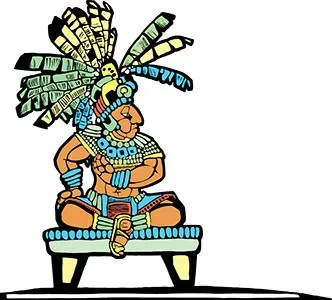 Cortez arrived in Aztec Mexico in 1519. The Aztec king Montezuma sent men with gifts to Cortez from Tenochtitlan, the capital city, trying to placate Cortez and to get him to stay away. Instead, the enormous gold and silver pieces excited Cortes. He sent them to Spain and they were given to the Holy Roman Emperor, Charles V, king of Spain. The riches lured Cortes to Tenochtitlan, where he took everything he could find. Most of the pieces he stole were melted down into bullion instead of being preserved in their native form, and even that which arrived at the court of Spain intact was almost entirely destroyed. On both of these journeys to the capital of the Aztecs, Cortes used the Aztec's enemies ï¾– the Tlaxcallan ï¾– to aid them in the attack.
Cortez arrived in Aztec Mexico in 1519. The Aztec king Montezuma sent men with gifts to Cortez from Tenochtitlan, the capital city, trying to placate Cortez and to get him to stay away. Instead, the enormous gold and silver pieces excited Cortes. He sent them to Spain and they were given to the Holy Roman Emperor, Charles V, king of Spain. The riches lured Cortes to Tenochtitlan, where he took everything he could find. Most of the pieces he stole were melted down into bullion instead of being preserved in their native form, and even that which arrived at the court of Spain intact was almost entirely destroyed. On both of these journeys to the capital of the Aztecs, Cortes used the Aztec's enemies ï¾– the Tlaxcallan ï¾– to aid them in the attack.
 The Aztec empire reached its height just a generation before the land was conquered by Cortes. Silver mines were discovered in northern Mexico around 1542 and when the Spanish established mining towns near these sources, silver was incorporated into jewelrymaking practice in the region as well. In 1822, Mexico revolted from Spain and declared her independence. Though Aztec culture was largely destroyed, descendents of indigenous people remain.
The Aztec empire reached its height just a generation before the land was conquered by Cortes. Silver mines were discovered in northern Mexico around 1542 and when the Spanish established mining towns near these sources, silver was incorporated into jewelrymaking practice in the region as well. In 1822, Mexico revolted from Spain and declared her independence. Though Aztec culture was largely destroyed, descendents of indigenous people remain.